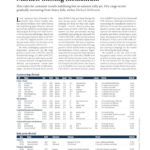Hire rates for container vessels stabilizing but no autumn rally yet. Dry cargo sector gradually recovering from heavy falls, writes Michael Hollmann
Liner operators have returned to the container ship charter market after the summer holidays, with weekly fixture lists lengthening again[ds_preview]. However, demand has not been sufficient to send charter rates back up again, barring a very small recovery for certain sizes and designs. Rate levels across the major segments from 4,250TEU to 1,100TEU slipped another 1.8% over the past weeks which is far less than in the previous period with a fall of 4.6%.
The most challenging segments from shipowners’ perspective are the large gearless sectors over 5,500TEU and the handy/feeder range of 1,000-2,000TEU, which both continue suffering from rather anaemic demand. Fixing levels for traditional »post-panamax« vessels have consolidated in the 12,000-14,000 $/day-range – far below the peak levels of more than 20,000$ that got fixed during the busy spring season. Spot time charter earnings for them are thus only slightly higher – if at all – than for classic panamax types of 4,250-5,100TEU. Broker reports say that spot/prompt tonnage availability kept going up especially for 5,500-7,500TEUs, with around a dozen units in search of immediate employment in mid-September. The lack of opportunities in typical long-haul trades for large gearless vessels results from an ongoing rationalisation of liner capacity, beginning with the transpacific trade and later spreading to the Australia, Middle East and to the FarEast-Europe trades. Recent moves include the early termination of a FE/E loop by the 2M carriers, the closure of a FE/Middle East loop by Gold Star Line, KMTC and others and the merger of two Med/US services by the Ocean and THE Alliances. Although not all these restructurings do immediately result in redeliveries of vessels, they provide the respective carriers with significant spare capacity for which they need to find alternative use before chartering in more ships. The impact on the market will thus be delayed. In fact, some of the early corrections announced for the transpacific trade already over the past months are just starting to impinge on the market now following the final sailings.
The problem is that the clock is ticking against tramp owners, with the Golden Week in China approaching fast. Most of the merchandise for the large import markets in Europe and the US (Xmas) gets shipped before Golden Week which generally marks the end of the cargo peak season.
By contrast, classic panamax ships have proven relatively immune against a downturn so far. A continued flow of fixtures and extensions served to keep tonnage supply reasonably tight at less than 10 spot units. Rates are stable at over 12,000$ in Asia so far and a couple thousands more in the Atlantic where tonnage availability is the tightest. It remains to be seen whether the combination of two transatlantic strings by the Ocean and THE Alliances may change the picture.
Below 4,000TEU, trading conditions in the charter market are more varied and tonnage demand pretty selective. The niche segment of 3,300-3,800TEU continues to see fairly stable levels between 12,000 and 13,300$. Although enquiry is reported to have waned a bit, very low availability of ships is offering protection against a deterioration.
Meanwhile, the 2,500-2,800TEU classes enjoyed fairly healthy demand again as interest picked up after the holidays. Spot supply remains tight for the main classes of 2,700TEU (g’less) and 2,500TEU (geared). The New ConTex shows rates for 2,700TEU types gaining more strength again following a rash of fixtures especially in the Atlantic, with 24 and 12 month durations assessed at around 12,200 and 11,350 and rising as per 20 September. There are still a few spot ships left in Asia but this could go down to zero again if the latest momentum is maintained, brokers said.
There is less optimism among owners of feeder ships with intakes below 2,000TEU, with demand reported to be very slow across the board. Alphaliner counted 16 open positions in the 1,500-1,900TEU segment in mid-September, evenly split between the Atlantic and Asia. The Golden Week holidays do not bode well while a number of Intra-Asia services are reportedly getting restructured, possibly resulting in more redeliveries of ships in the coming weeks. Yet, rate developments were positive in some areas over the past weeks, highlighted by a recovery in levels to over 10,000$ for Wenchong 1,700TEU types in Asia. Smaller feeder vessels of 1,100TEU and below continue to be confronted with low demand, keeping rates for CV1100’s at low 7,000’s $ and low 6,000’s $ in Asia and the Med, respectively. Due to schedule disruptions caused by typhoons in the Far East, brokers have seen an influx of short term requirements for extra tonnage which offers some stability to rates.
Dry cargo market suffers
The dry cargo market suffered quite a steep fall since the middle of August, reflecting unexpected weakness in the capesize segment where spot time charter averages fell by around one third. The troubles result from another lull in iron ore chartering activity ex Brazil although steel production in China continued to expand at a fast pace, according to latest available figures. Period activity and FFA rates still reflect optimism for the fourth quarter which is usually the busiest for spot capesize chartering. Cargoes for China are expected to pick up again boosting rates, given the relatively low stock levels in the ports there (147.1mill. t, according to SSY).
For panamaxes and especially the smaller geared types, the trend has been more positive, with a rise in coals and minerals business for panamaxes in the Pacific and good demand for handy bulkers in South America and the US Gulf underpinning rates.
Time charter rates for multipurpose/heavy lift ships continued to recover as well, with the Toepfer Multipurpose Index for 12,500 dwt F-type vessels reaching a year-to-date high of 7,385$/day for September.
Michael Hollmann

















